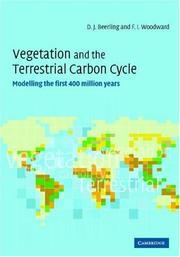| Listing 1 - 3 of 3 |
Sort by
|
Book
ISBN: 047110051X 9780471100515 Year: 1981 Volume: 16 Publisher: Chichester : John Wiley,
Abstract | Keywords | Export | Availability | Bookmark
 Loading...
Loading...Choose an application
- Reference Manager
- EndNote
- RefWorks (Direct export to RefWorks)
Carbon cycle (Biogeochemistry) --- Mathematical models --- Carbon cycle (Biogeochemistry) - Mathematical models --- CARBON --- CARBON CYCLE --- SIMULATION MODEL --- OCCURENCE
Book
ISBN: 9780691017075 0691017077 Year: 2006 Publisher: Princeton, N.J. : Oxford : Princeton University Press,
Abstract | Keywords | Export | Availability | Bookmark
 Loading...
Loading...Choose an application
- Reference Manager
- EndNote
- RefWorks (Direct export to RefWorks)
'Ocean Biogeochemical Dynamics' provides a broad theoretical framework upon which graduate students and upper-level undergraduates can formulate an understanding of the processes that control the mean concentration and distribution of biologically utilized elements and compounds in the ocean. Though it is written as a textbook, it will also be of interest to more advanced scientists as a wide-ranging synthesis of our present understanding of ocean biogeochemical processes. The first two chapters of the book provide an introductory overview of biogeochemical and physical oceanography. The next four chapters concentrate on processes at the air-sea interface, the production of organic matter in the upper ocean, the remineralization of organic matter in the water column, and the processing of organic matter in the sediments. The focus of these chapters is on analyzing the cycles of organic carbon, oxygen, and nutrients. The next three chapters round out the authors' coverage of ocean biogeochemical cycles with discussions of silica, dissolved inorganic carbon and alkalinity, and CaCO3. The final chapter discusses applications of ocean biogeochemistry to our understanding of the role of the ocean carbon cycle in interannual to decadal variability, paleoclimatology, and the anthropogenic carbon budget. The problem sets included at the end of each chapter encourage students to ask critical questions in this exciting new field. While much of the approach is mathematical, the math is at a level that should be accessible to students with a year or two of college level mathematics and/or physics.
Chemical oceanography --- Biogeochemistry --- Océanographie chimique --- Biogéochimie --- Mathematical models --- Biogeochemistry. --- Chemical oceanography. --- Mathematical models. --- Océanographie chimique --- Biogéochimie --- Marine chemistry --- Océanographie chimique. --- Biogéochimie. --- Modèles mathématiques --- Modèles mathématiques. --- Oceanography --- Water chemistry --- Biochemistry --- Geochemistry --- Chemical oceanography - Mathematical models --- Biogeochemistry - Mathematical models --- Océanographie chimique. --- Biogéochimie. --- Modèles mathématiques.

ISBN: 9780511541940 9780521801966 0511016271 9780511016271 0521801966 051104772X 9780511047725 051117473X 9780511174735 1107122902 9781107122901 1280433159 9781280433153 0511154755 9780511154751 9786610433155 6610433151 0511541945 0511303734 9780511303739 Year: 2001 Publisher: Cambridge New York Cambridge University Press
Abstract | Keywords | Export | Availability | Bookmark
 Loading...
Loading...Choose an application
- Reference Manager
- EndNote
- RefWorks (Direct export to RefWorks)
Plants have colonised and modified the World's surface for the last 400 million years. In this book the authors demonstrate that an understanding of the role of vegetation in the terrestrial carbon cycle during this time can be gained by linking the key mechanistic elements of present day vegetation processes to models of the global climate during different geological eras. The resulting interactive simulations of climate and vegetation processes tie in with observable geological data, such as the distributions of coals and evaporites, supporting the validity of the authors' approach. Simulation of possible conditions in future centuries are also presented, providing valuable predictions of the status of the Earth's vegetation and carbon cycle at a time of global warming.
Carbon cycle (Biogeochemistry) --- Plant ecology --- Paleoclimatology --- Geologic climate --- Palaeoclimatology --- Paleoclimate --- Climatic changes --- Climatology --- Botany --- Phytoecology --- Plants --- Vegetation ecology --- Ecology --- Global carbon cycle --- Biogeochemical cycles --- Mathematical models. --- Floristic ecology --- Mathematical models --- Carbon cycle (Biogeochemistry) - Mathematical models --- Plant ecology - Mathematical models --- Paleoclimatology - Mathematical models
| Listing 1 - 3 of 3 |
Sort by
|

 Search
Search Feedback
Feedback About UniCat
About UniCat  Help
Help News
News